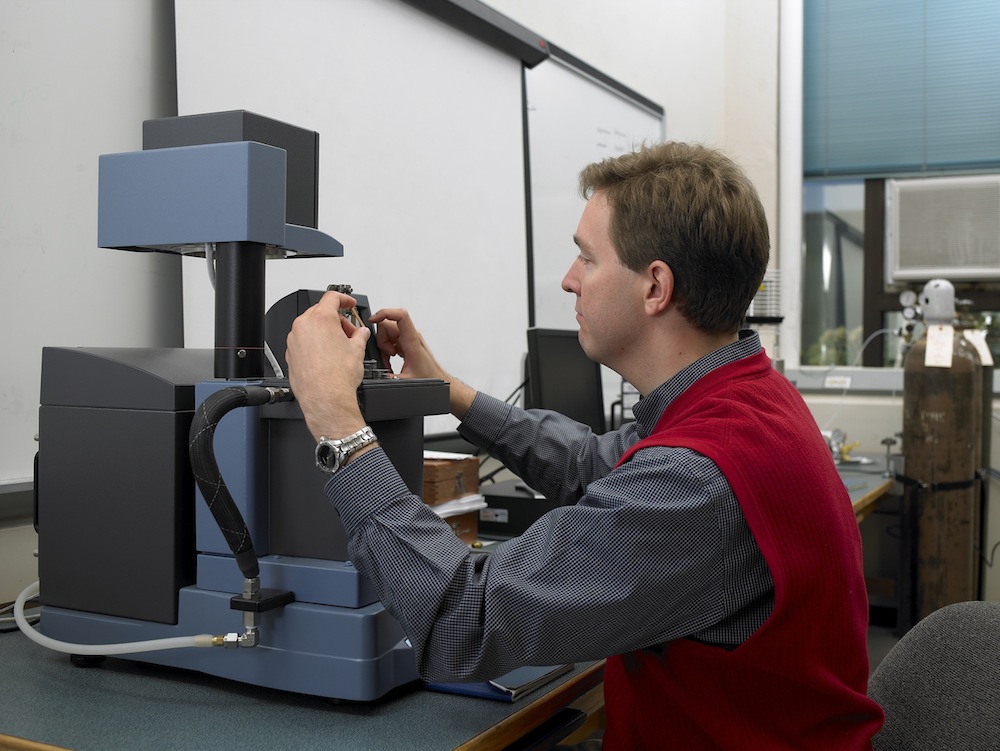Researching Biorenewable Plastics and Self-Healing Composites

This ScienceLives article was provided to LiveScience in partnership with the National Science Foundation.
Michael Kessler is an associate professor of materials science and engineering at Iowa State University where he teaches and directs the Polymer Composites Research Group of graduate students and postdocs. His current work, funded by the National Science Foundation, focuses on biorenewable polymers that offer alternatives to petroleum based plastics. In addition to his responsibilities as a professor, he is an associate of the Department of Energy's Ames Laboratory. His honors include the Army Research Office Young Investigator Award, the Air Force Office of Scientific Research Young Investigator Award, the NSF CAREER Award and the Elsevier Young Composites Researcher Award from the American Society for Composites. Kessler has worked at the forefront of the rapidly emerging field of self-healing polymers and composites for the last decade. Along with his graduate student, Tim Mauldin, he recently published a major critical review of the field, available here.
Name: Michael Kessler Age: 36 Institution: Iowa State University Field of Study: Materials Science and Engineering with a focus on polymers and composite materials
What inspired you to choose this field of study? In college I had an excellent teacher for a class called Mechanics of Materials. I found the class fascinating, and he encouraged me to pursue graduate school in that field. While in graduate school, I spent my first year as a teaching assistant while I tried to decide on a research advisor and thesis project. I found a professor that was initiating a new research project on self-healing composite materials, and I decided to pursue my Ph.D. research on the topic. I never regretted that decision. By the time I graduated with my Ph.D. in 2002, we had published the results of our research in the prestigious journal Nature, and the research had been featured in a wave of print, radio and television media.
What is the best piece of advice you ever received? Many years ago, I read the book "The Seven Habits of Highly Effective People" by Stephen Covey (Free Press, 1990). One of the habits in that book has had a profound effect on my thinking: "Put first things first." Essentially, the advice is to organize and execute around priorities — to plan, prioritize and perform your tasks in such a way that you focus on the important things rather than those things that are urgent, but unimportant.
What was your first scientific experiment as a child? I'm not really sure. I grew up in the Black Hills of South Dakota, and I spent a lot of time playing in the woods near my house. I remember doing experiments to try to make pictures using pigments from the natural materials that I'd find in the woods (such as flower petals and charcoal). Perhaps these were my first scientific experiments.
What is your favorite thing about being a researcher? I like the intellectual freedom to pursue the problems that I am most interested in, to try to discover new phenomena and to answer the question: "How does this work?" I also enjoy working with all of the bright students and postdocs that I get to collaborate with.
Get the world’s most fascinating discoveries delivered straight to your inbox.
What is the most important characteristic a researcher must demonstrate in order to be an effective researcher? I think that creativity is the most important attribute of an effective researcher. Of course, effective researchers must be technically competent, observant, good communicators and hardworking. But if they do not have good creative problem solving skills, they will not make the breakthroughs that come with a fresh approach to old problems.
What are the societal benefits of your research? The benefits of our research include safer and more damage-tolerant polymer structures in aerospace, medical and general consumer products; wider use of polymers derived from renewable biological feedstock rather than petroleum, which would reduce the carbon footprint of polymer products and strengthen agricultural and rural economies; and the development of new polymeric materials with added value and properties not presently available in commercial plastics and composites.
Who has had the most influence on your thinking as a researcher? I've had many great mentors over the years: my high school teachers, college professors and Ph.D. advisor, but my parents probably had the biggest influence on my thinking. My dad instilled in me an appreciation for critical thinking and how to interpret the world around me, and my mom encouraged me to pursue my talents in math, science and communication.
What about your field or being a researcher do you think would surprise people the most? A lot of a researcher's time is spent writing. This is especially true for a professor, where most of the lab work is done by graduate students, while the professor works on papers, reports and research proposals.
If you could only rescue one thing from your burning office or lab, what would it be? Since all of my computer data is backed up on a remote server, I would choose my lab notebooks.
What music do you play most often in your lab or car? In my office, I like to listen to instrumental music on Pandora.com, because music with lyrics tends to distract me while I work. One of the stations I choose often is Acoustic Alchemy. If I'm by myself in the car, I like to listen to audio books from the public library. When I'm driving with my family, we usually are listening to kids' music like the Veggie Tales.
Editor's Note: This research was supported by the National Science Foundation (NSF), the federal agency charged with funding basic research and education across all fields of science and engineering. Any opinions, findings, and conclusions or recommendations expressed in this material are those of the author and do not necessarily reflect the views of the National Science Foundation. See the ScienceLives archive.



